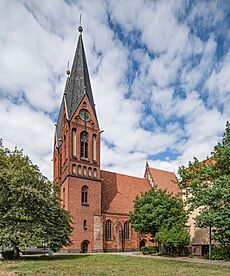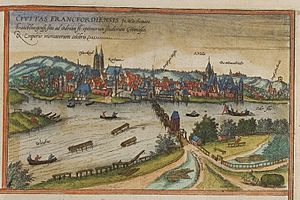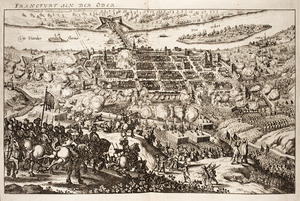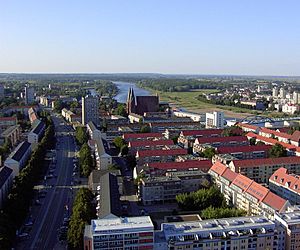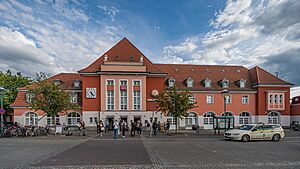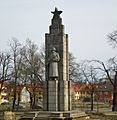Frankfurt (Oder) facts for kids
Quick facts for kids
Frankfurt (Oder)
Frankfurt an der Oder Frankfort an de Oder |
|||
|---|---|---|---|
|
|||
| Country | Germany | ||
| State | Brandenburg | ||
| District | Urban district | ||
| Elevation | 19-135 m (−423.9 ft) | ||
| Population
(2022-12-31)
|
|||
| • Total | 58,230 | ||
| Time zone | CET/CEST (UTC+1/+2) | ||
| Postal codes |
15201–15236
|
||
| Dialling codes | 0335 | ||
| Vehicle registration | FF | ||
| Website | www.frankfurt-oder.de | ||
Frankfurt (Oder) is a city in Germany. It is also known as Frankfurt an der Oder, which means "Frankfurt on the Oder River". This helps people tell it apart from the larger city of Frankfurt am Main.
Frankfurt (Oder) is the fourth-largest city in the German state of Brandenburg. About 58,000 people live there. It is the biggest German city right on the Oder River. It is also one of the cities furthest east in Germany.
The city sits on the western side of the Oder River. Right across the river is the Polish town of Słubice. Słubice used to be part of Frankfurt until 1945. Frankfurt is about 80 kilometers (50 miles) east of Berlin. The name "Frankfurt" means "Ford of the Franks". A "ford" is a shallow place where you can cross a river.
The city's recorded history began in the 1200s. It started as a settlement of West Slavic people. Over time, it was part of different kingdoms and states. These included the Kingdom of Poland, Brandenburg, and Prussia.
After World War II, the eastern part of Frankfurt became part of Poland. This happened because of the Potsdam Agreement. That part was renamed Słubice. The western part of Frankfurt became a border city in East Germany.
During the time of East Germany, Frankfurt's population grew. It reached over 87,000 people in the late 1980s. After Germany became one country again, the population went down. But it has stayed steady at about 58,000 people recently. Today, Frankfurt is important for good relations between Germany and Poland. It is home to the European University Viadrina. This university even has a campus in Słubice, called the Collegium Polonicum.
Contents
- History of Frankfurt (Oder)
- Population of Frankfurt (Oder)
- European University in Frankfurt (Oder)
- Getting Around Frankfurt (Oder)
- Sports in Frankfurt (Oder)
- Frankfurt (Oder) and International Connections
- City Government
- Sister Cities
- Famous People from Frankfurt (Oder)
- Films Set in Frankfurt (Oder)
- Climate
- Images for kids
- See also
History of Frankfurt (Oder)
Early Beginnings and Growth
Before 1249, there was a West Slavic settlement called Zliwitz. This area was part of the Kingdom of Poland. In 1225, a Polish duke named Henry the Bearded gave Zliwitz special trading rights. In 1226, building began on the St. Nicholas Church. Today, this church is called the Friedenskirche (Church of Peace). In 1249, the settlement became part of a region called Brandenburg.
The town of Frankfurt officially became a city in 1253. The first settlers lived on the western side of the Oder River. Later, the town grew to include the eastern side. In 1319, a war started over who controlled the region. The town then came under the control of the Duchy of Pomerania. The Duke of Pomerania, Wartislaw IV, gave the town new special rights. But by 1324, the town was back under Brandenburg's control.
In the later Middle Ages, Frankfurt was very important for river trade. Goods were moved between cities like Wrocław and Szczecin. From 1373 to 1415, Frankfurt was part of the Lands of the Bohemian Crown. In 1430, Frankfurt joined the Hanseatic League. This was a powerful group of trading cities. In 1432, a group of Czech reformers called the Hussites took over the town.
Frankfurt in Modern Times
In the 1500s, many goods from western Poland were sent through Frankfurt. These goods included grain, wood, and tar. They were floated down the Oder River to the port of Szczecin. In the early 1600s, the high taxes on Polish goods were lowered.
In April 1631, during the Thirty Years' War, a battle happened in Frankfurt. Swedish forces, helped by Scottish soldiers, attacked the town. They stormed the town and destroyed many buildings. The Swedes won this battle. By the end of the Thirty Years' War, the town's population had dropped a lot. It went from 12,000 people to only 2,366.
The oldest church in town, the Friedenskirche, was used for other things in the 1500s. It was even used to store grain. From the 1600s, it became a church for French Huguenots.
In August 1759, the city was briefly taken over by the Russian army. This happened during the Seven Years' War.
In 1815, Frankfurt became part of the Province of Brandenburg. This was after the Napoleonic Wars. In the 1800s, Frankfurt was very important for trade. It was located between Berlin and Poznań on the busy Oder River. The city had the second-largest yearly trade fair in Germany. Only Leipzig had a bigger one.
Many Polish people escaping the November Uprising passed through the city. This uprising was against foreign rule in Poland. In 1842, a railway line opened between Berlin and Frankfurt.
World War II and Recent Changes
Before World War II, a German military group was formed in Frankfurt. This group later entered Polish cities to commit crimes against Poles. During the war, many people from Poland and the Soviet Union were forced to work in Frankfurt.
In early 1945, prisoners from camps were forced on long, difficult journeys through the city. These journeys were to the Sachsenhausen concentration camp. There was no major fighting in Frankfurt in 1945. The city was declared a "fortress" to try and stop the Red Army from reaching Berlin. But the city was almost empty. The Red Army later burned down much of the town.
After the war, the Germany–Poland border was set along the Oder River. This separated the eastern part of Frankfurt, which became the Polish town of Słubice. The western part of Frankfurt became a border city in East Germany.
After East and West Germany reunited in 1990, Frankfurt faced challenges. Its main employer, a semiconductor factory, closed down. This led to high unemployment and slow economic growth. The population dropped a lot from 87,000 in 1990.
Today, Frankfurt and Słubice are friendly neighbors. They work together on many projects. Poland joined the European Union in 2004. In 2007, border checks were removed. This made it even easier for people to move between the two towns.
In 2008, the Jewish community in Frankfurt celebrated a special event. They dedicated their first Torah scroll since the Holocaust. The procession started where the old synagogue stood before World War II.
Population of Frankfurt (Oder)
Frankfurt (Oder) has seen its population change over the years. In the late 1800s, it had about 43,000 people. By the 1930s, it grew to over 65,000. After World War II, the population dropped.
During the time of East Germany, the population grew again. It reached its highest point in 1989 with over 87,000 people. After Germany reunited, the population went down. But in recent years, it has become stable. In 2020, about 57,000 people lived in Frankfurt (Oder).
European University in Frankfurt (Oder)
Frankfurt (Oder) has a long history of education. The first university in the region was the Alma Mater Viadrina. It was founded in 1506. A famous person who studied there was Albert of Brandenburg. He later became a strong opponent of the Protestant Reformation. The university closed in 1811. Its resources were used to help start two new universities. These were the Humboldt University in Berlin and the University of Wrocław.
The university was reopened in 1991. It is now called the Viadrina European University. It focuses on European studies and works closely with a Polish university. They even run a joint campus in Słubice called the Collegium Polonicum.
Getting Around Frankfurt (Oder)
The main railway station in Frankfurt (Oder) is an important transport hub. You can catch the Berlin-Warszawa-Express train there. There are also regular trains to cities like Magdeburg and Cottbus.
Within the city, there is a network of five tram lines. Trams are a great way to travel around Frankfurt.
Sports in Frankfurt (Oder)
The city's local football (soccer) team is called 1. FC Frankfurt.
Frankfurt (Oder) and International Connections
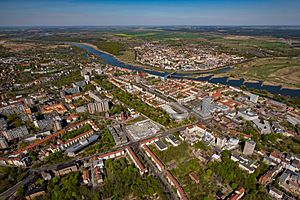
Frankfurt (Oder) is on the border with Poland. This makes it special for German–Polish relations and European integration. The European University Viadrina has a building in Słubice, Poland. The university also has many projects to bring Germany and Poland closer. It offers free Polish language courses to its students.
Another project that helps connect Germany and Poland is the Fforst House. This is a project run by German and Polish students. The city and the university support it. A former university president called it the place where "Europe begins."
City Government
Mayor and City Council
The current mayor of Frankfurt (Oder) is René Wilke. He became mayor in 2018. The city council works with the mayor to govern the city. The most recent city council election was held in June 2024.
Sister Cities
Frankfurt (Oder) has many sister cities around the world. These partnerships help build friendships and cultural exchange.
- Gorzów Wielkopolski, Poland (since 1975)
- Heilbronn, Germany (since 1988)
- Kadima-Zoran, Israel (since 1997)
- Nîmes, France (since 1976)
- Słubice, Poland (since 1975)
- Vantaa, Finland (since 1987)
- Vitebsk, Belarus (since 1991)
- Vratsa, Bulgaria (since 2009)
- Yuma, United States (since 1997)
Famous People from Frankfurt (Oder)
Many interesting people have come from Frankfurt (Oder). Here are a few:
- Heinrich von Kleist (1777–1811), a famous German poet and writer.
- Hermann Wissmann (1853–1905), a German explorer and administrator in Africa.
- Georg Michaelis (1857–1936), who was the Chancellor of Germany for a few months in 1917.
- René Wilke (born 1984), the current mayor of Frankfurt (Oder).
- Hermann Weingärtner (1864–1919), a German gymnast who won medals at the first modern 1896 Summer Olympics.
- Klaus Köste (1943–2012), a German gymnast who won a gold medal at the 1972 Summer Olympics.
Films Set in Frankfurt (Oder)
Frankfurt (Oder) has been the setting for several German films:
- Halbe Treppe (Grill Point, 2002)
- Lichter (Distant Lights, 2003)
- Die Kinder sind tot (The Children Are Dead, a documentary from 2004)
- No Exit (2004, a documentary)
- Kombat Sechzehn (Combat Sixteen, 2005)
Climate
| Climate data for Manschnow (1991–2020 normals) | |||||||||||||
|---|---|---|---|---|---|---|---|---|---|---|---|---|---|
| Month | Jan | Feb | Mar | Apr | May | Jun | Jul | Aug | Sep | Oct | Nov | Dec | Year |
| Mean daily maximum °C (°F) | 2.9 (37.2) |
4.7 (40.5) |
8.9 (48.0) |
15.3 (59.5) |
19.7 (67.5) |
23.0 (73.4) |
25.3 (77.5) |
25.1 (77.2) |
20.1 (68.2) |
14.2 (57.6) |
7.6 (45.7) |
3.9 (39.0) |
14.2 (57.6) |
| Daily mean °C (°F) | 0.4 (32.7) |
1.5 (34.7) |
4.4 (39.9) |
9.5 (49.1) |
14.0 (57.2) |
17.3 (63.1) |
19.5 (67.1) |
19.0 (66.2) |
14.6 (58.3) |
9.7 (49.5) |
4.7 (40.5) |
1.6 (34.9) |
9.7 (49.4) |
| Mean daily minimum °C (°F) | −2.3 (27.9) |
−1.8 (28.8) |
0.2 (32.4) |
3.5 (38.3) |
7.7 (45.9) |
11.1 (52.0) |
13.4 (56.1) |
13.0 (55.4) |
9.4 (48.9) |
5.6 (42.1) |
1.8 (35.2) |
−0.9 (30.4) |
5.1 (41.1) |
| Average precipitation mm (inches) | 33.1 (1.30) |
25.3 (1.00) |
29.1 (1.15) |
26.6 (1.05) |
49.2 (1.94) |
49.3 (1.94) |
74.2 (2.92) |
59.0 (2.32) |
42.9 (1.69) |
34.8 (1.37) |
32.2 (1.27) |
29.6 (1.17) |
485.3 (19.12) |
| Average precipitation days (≥ 1.0 mm) | 15.5 | 13.5 | 13.6 | 10.4 | 12.6 | 12.9 | 14.2 | 12.3 | 11.0 | 13.0 | 13.4 | 15.2 | 157.6 |
| Average snowy days (≥ 1.0 cm) | 7.6 | 6.4 | 2.5 | 0.2 | 0 | 0 | 0 | 0 | 0 | 0.1 | 1.0 | 4.6 | 22.4 |
| Average relative humidity (%) | 86.3 | 82.6 | 77.6 | 69.2 | 69.5 | 69.8 | 69.9 | 70.0 | 76.2 | 82.9 | 88.5 | 87.9 | 77.5 |
| Mean monthly sunshine hours | 53.4 | 77.5 | 128.6 | 204.0 | 233.4 | 235.2 | 235.2 | 227.1 | 163.8 | 110.4 | 57.0 | 43.7 | 1,769.3 |
| Source: NOAA | |||||||||||||
Images for kids
-
Nicolaus Copernicus monument
See also
 In Spanish: Fráncfort del Óder para niños
In Spanish: Fráncfort del Óder para niños










